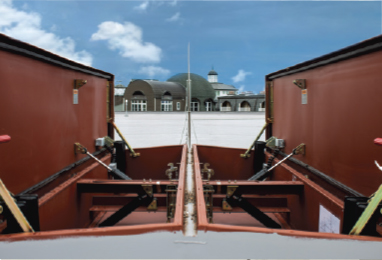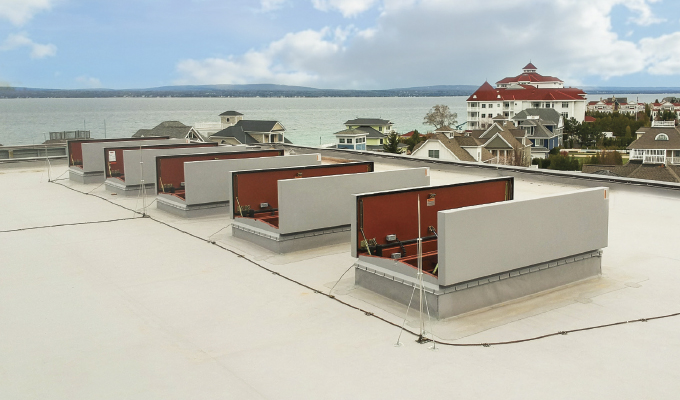New arts facility in Michigan incorporates regional splendor in creative design
By Thomas Renner
Photos by Brooksie Productions
When architects and contractors took on the project to build the Great Lakes Center for the Arts, they faced an assortment of dilemmas. The tight footprint, the challenge to incorporate the beautiful natural surroundings into the architecture, and working conditions in the brutal Northern Michigan winters were some of the concerns that workers faced.
Throughout it all, however, the teams focused on a singular objective: pleasing the patrons who will attend the myriad of shows that will be performed at the Center. The Detroit Symphony Orchestra struck the first notes in the summer of 2018 at the $25 million, 525-seat, 40,000-square-foot facility, ending a conceptual, design and construction process that extended over two decades. In the end, the goal to erect a crowd-pleasing, the state-of-the-art venue was achieved.
“Design is certainly a fluid, creative process,’’ says Jill O’Neill, the Center’s executive director. “Driving each decision was the 1999 Cultural Plan, with the goal to develop a performing space that is technically suitable for artists and both welcoming and comfortable for patrons. Throughout the value engineering phase, the determining factor was to ensure a high-caliber artistic and patron experience, and that was never compromised.”
A LONG-TIME VISION
The Center in Petoskey, Michigan, will serve as a hub for a region teeming with cultural organizations. The area is home to thousands of artists, musicians, writers, actors, and other creative minds. There are more than 100 arts and cultural organizations in the 10-county region. It is also a tourist destination with activities, restaurants, and events throughout the year.

Center for the Arts in Petoskey, Michigan. The vents protect property and aid firefighters in bringing a fire under control by removing smoke, heat, and gases from a burning building.
Roots for the facility date back to the 1990s, when a Community Cultural Plan for Emmet and Charlevoix Counties prioritized development of additional cultural facilities and envisioned the addition of a unique performing arts center for the region.
“The vision of the Center is to serve as a social and cultural hub for Northern Michigan, to serve as a leading education provider and, over time, to become a nationally-recognized institution for unique cultural performances and events,’’ says O’Neill.
TECHNICAL AND AESTHETIC DETAIL
The Center will host audiences attending performances for classical music, ballet, intellectual dialogue, comedy, country music, jazz, cinema, and more. The building includes digital sound technology that is found in only a few theaters across the country, and a 45-foot cinema screen with powerful theatrical surround sound for cinema and presentations.
The theater designers, Fisher Dachs Associates, and the architectural team at TowerPinkster identified solutions that make the venue enticing for performers and patrons. The multi-channel sound reinforcement system includes line array loudspeakers that meet the requirements of celebrity performers’ technical requirements and electronic architecture that allows acoustics of the venue to be optimized to meet the varied requirements of the wide range of programming. The sound system includes about 100 loudspeakers discreetly located within the audience chamber that supports Dolby Almos cinema sound playback.
“This building adds a space for world-class performers that did not exist in northern Michigan,’’ says Jason Novotny, the lead architect for TowerPinkster. “It adds to the valuation of the performing arts community that was intended by the clients.”
CRITICAL SAFETY FEATURE
Acoustical smoke vents manufactured by The BILCO Company played an important role in the construction of the Center. The vents feature an STC and OITC sound rating to block outside noise to maintain the quality of the sophisticated sound system used at the facility.
Architectural Building Products provided five vents for Modern Roofing to install at the facility, and the vents protect property and aid firefighters in case of fire. Vents help firefighters bring a blaze under control by removing smoke, heat, and gases from a burning building. The vents also allow air quality and visibility to be maintained inside the theater so that patrons can exit safely, and firefighters can enter to do their job.
“With the potential for more than 500 visitors for larger events, our team knew we would have a need for a dependable smoke ventilation system,’’ Novotny says. “With this being a high-performing acoustical environment, we designed a separate structure for the performance hall from the remainder of the building. This was solely for acoustical isolation of building elements. The BILCO acoustical smoke vents became a part of this ‘shell within a shell’ with their acoustical sound-reducing characteristics.”
REFLECTING REGIONAL BEAUTY
Besides the technical detail, Novotny’s team also needed to display in the grandeur of the community. “They wanted spaces that were uniquely Northern Michigan in their feel, and approachable as a community amenity,’’ Novotny says.
To accomplish that objective, architects specified aged copper, Petoskey stone, natural sedimentary rock, and colors that reflect the beautiful waters of Lake Michigan. The Center sits just steps from Little Traverse Bay.
VITAL COMMUNITY ASSET
The Center has quickly shown its strength as a regional asset. During its inaugural year, the venue partnered with groups such as Bay View Music Festival, The Charlevoix Circle of Arts Cummings Quartet and the Dorothy Gerber Strings Program, Crooked Tree Arts Center, CTAC’s Up North Vocal Institute, Great Lakes Chamber Orchestra and the University of Michigan School of Music.
Area groups who have performed at the Center have seen a growth in their patron base, and local students are benefitting from top-notch artistic instruction.
O’Neill says direct and indirect employment, tourism, and the ability to recruit and retain talent in the region translates to a $10 to $20 million economic stimulus for Northern Michigan. The community vision that developed long ago has been a welcome addition to the region.
About the author
Thomas Renner writes on building, construction and other trades for publications throughout the United States.
Modern Contractor Solutions, July 2019
Did you enjoy this article?
Subscribe to the FREE Digital Edition of Modern Contractor Solutions magazine.



